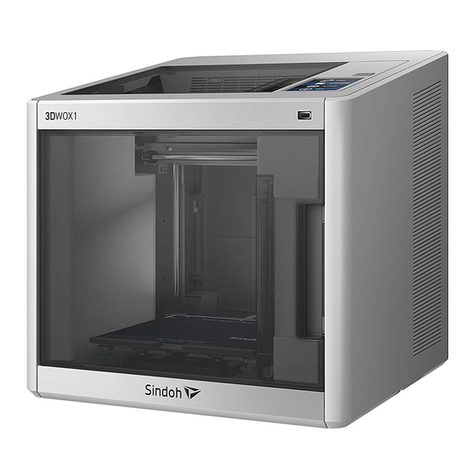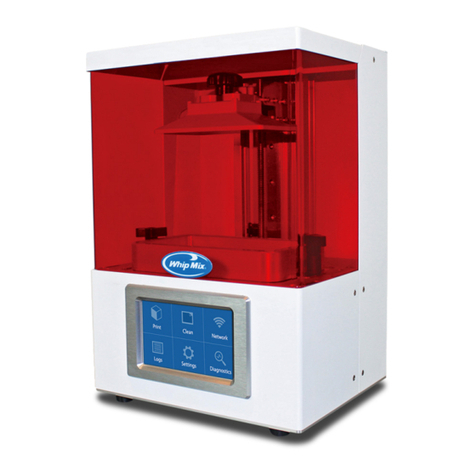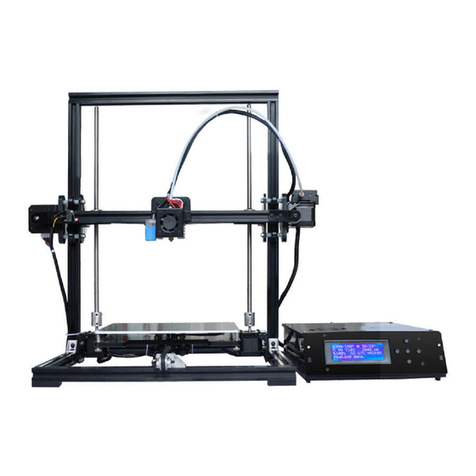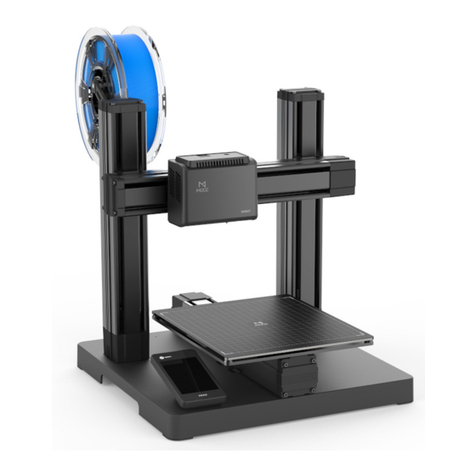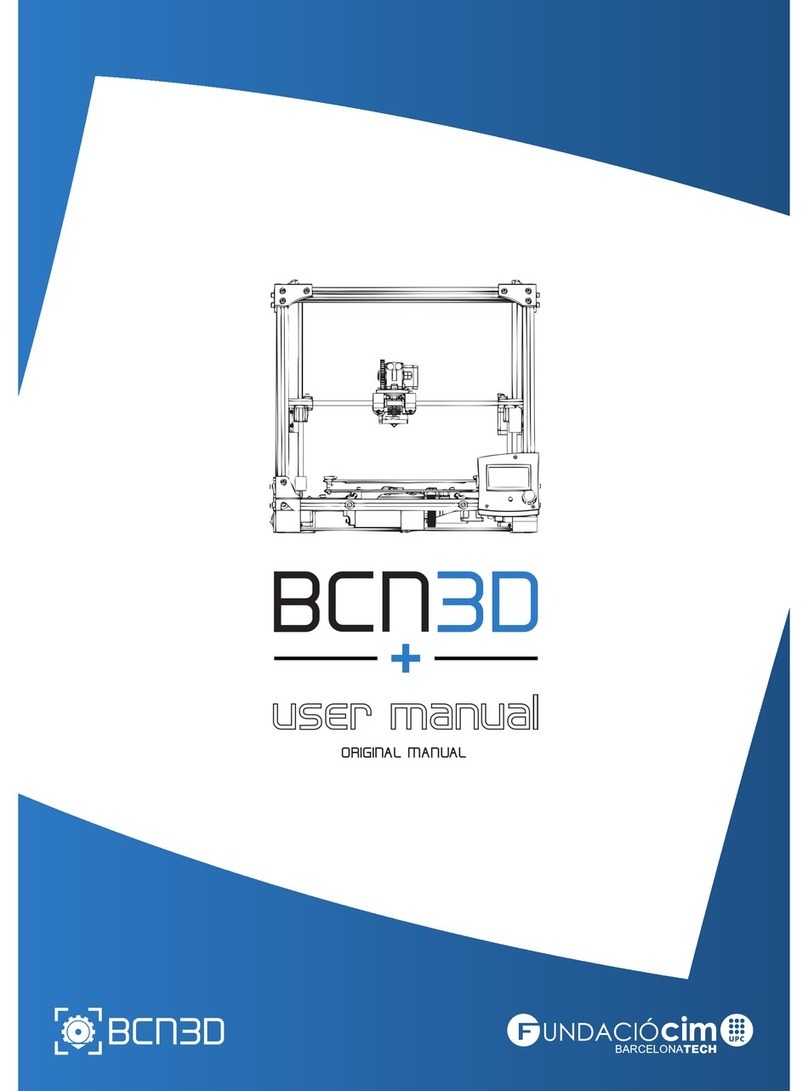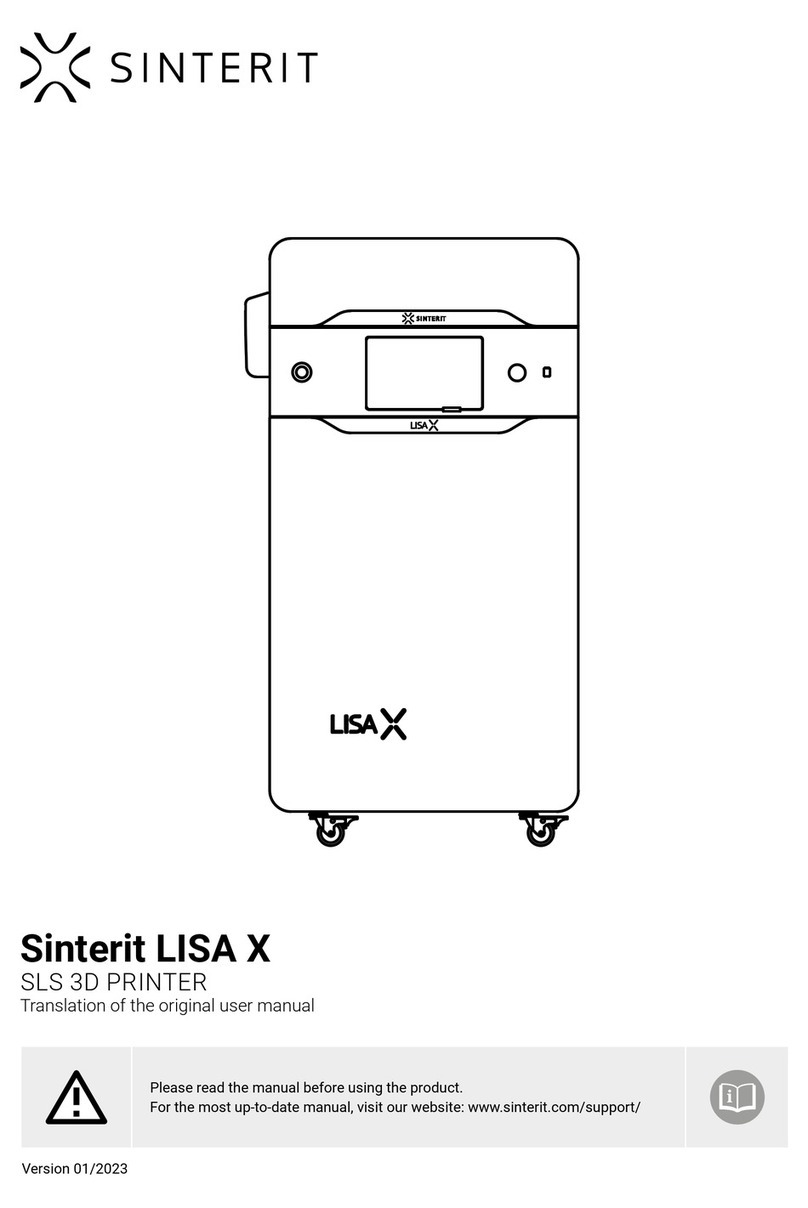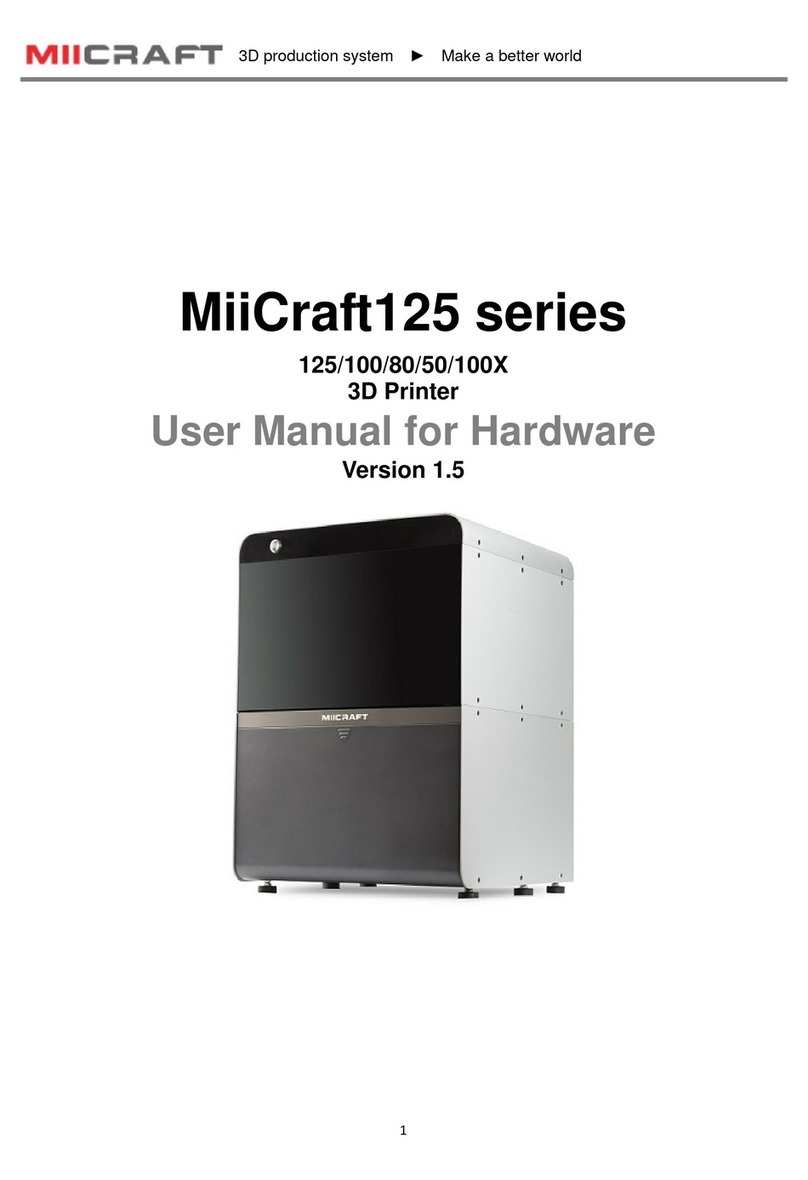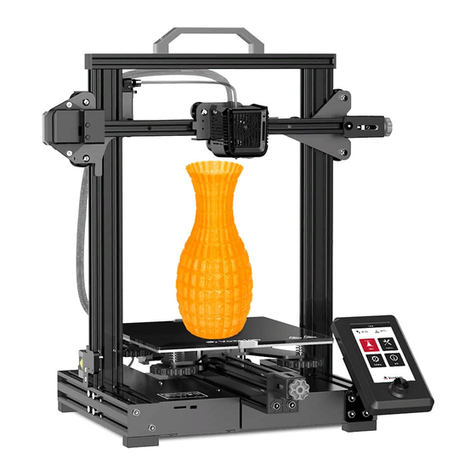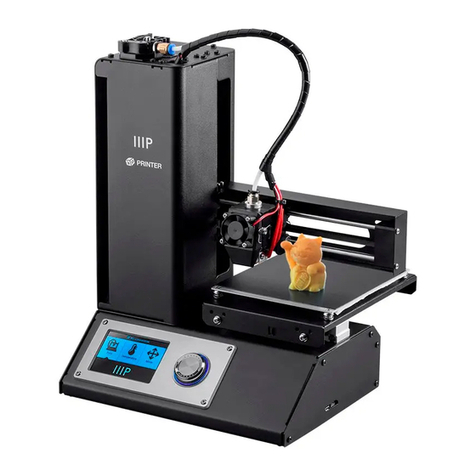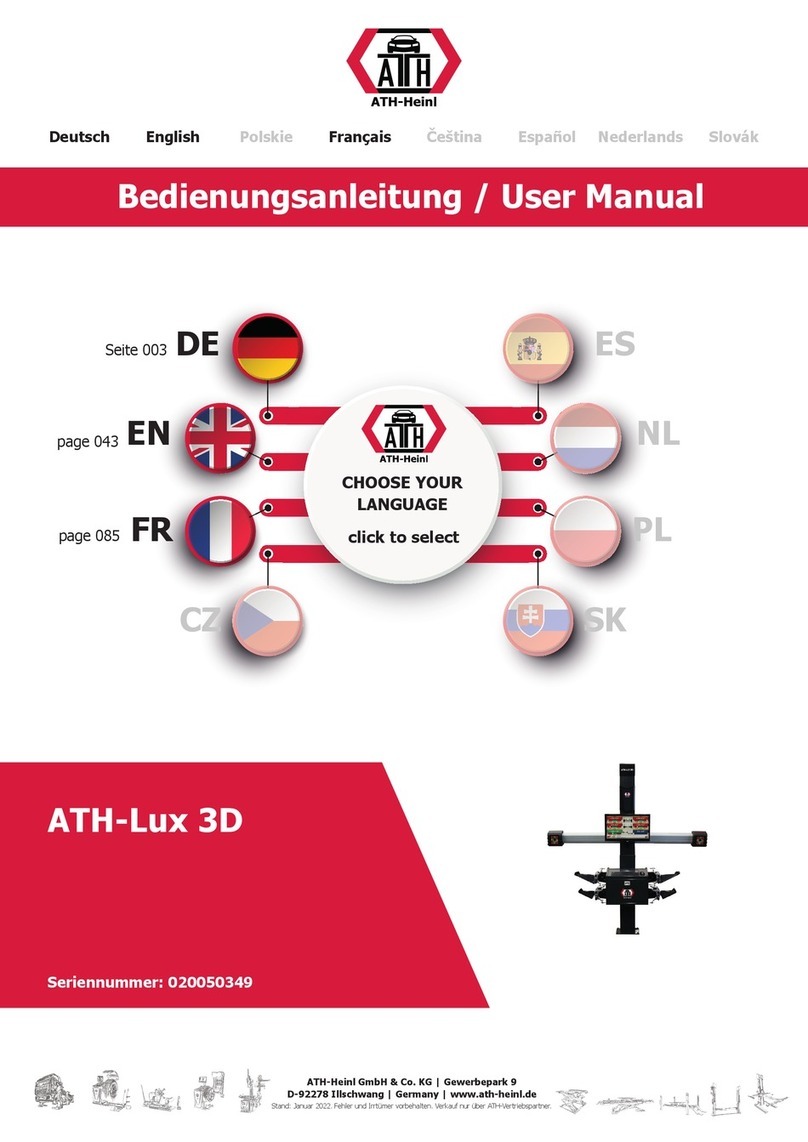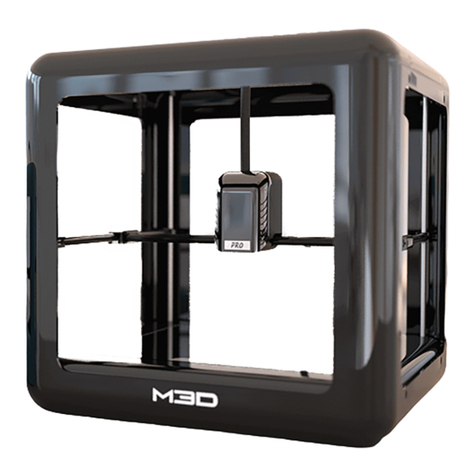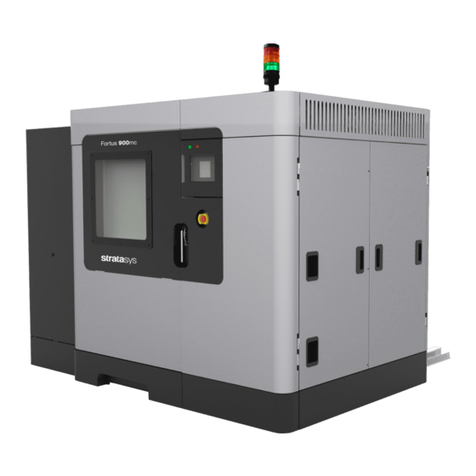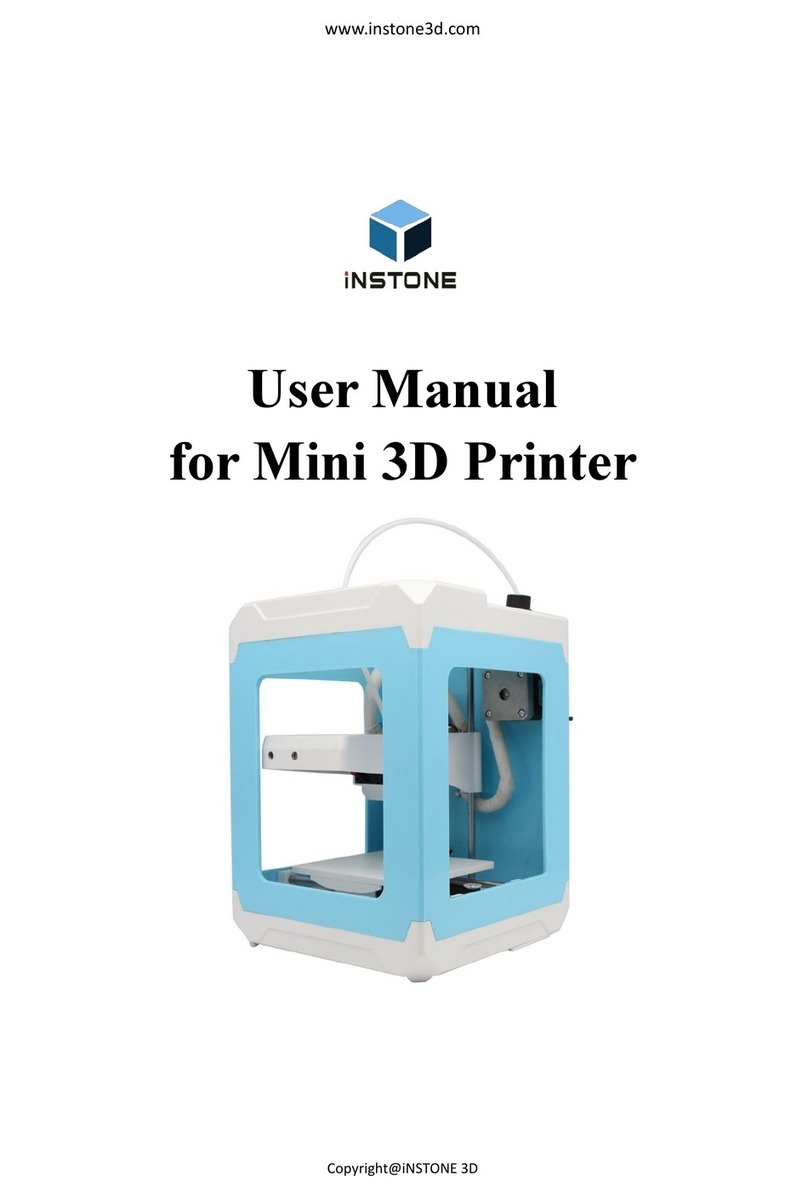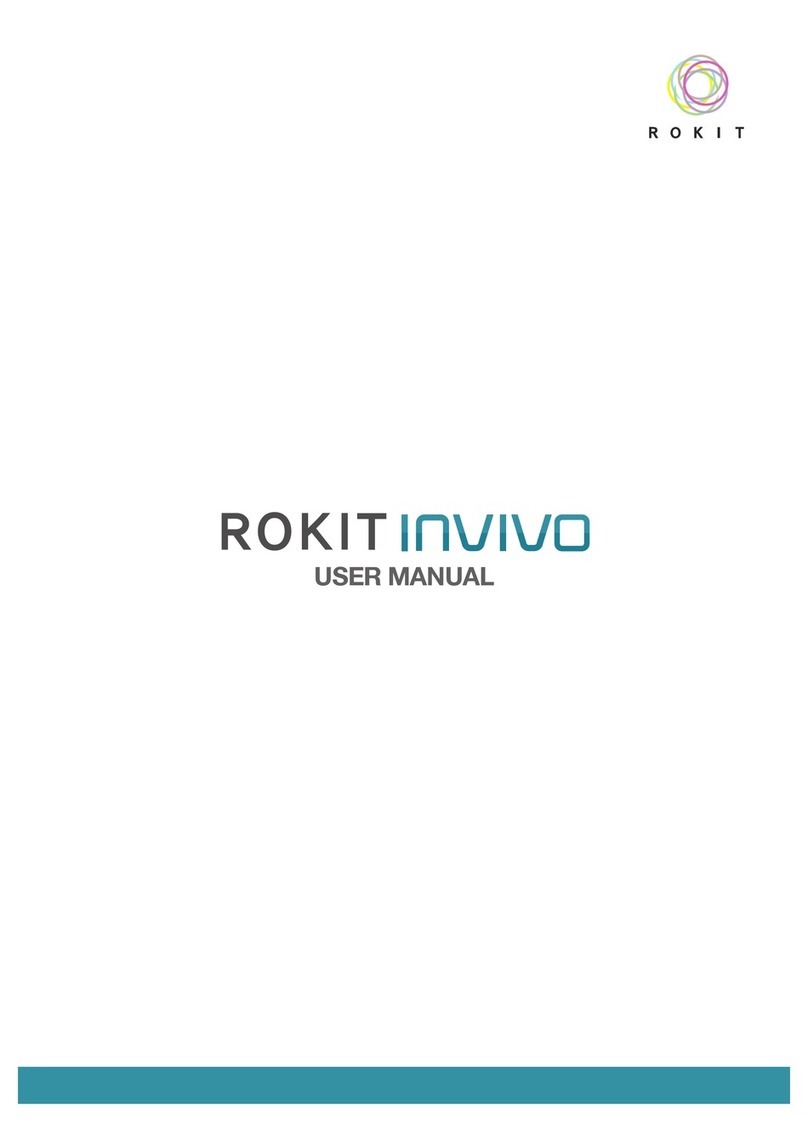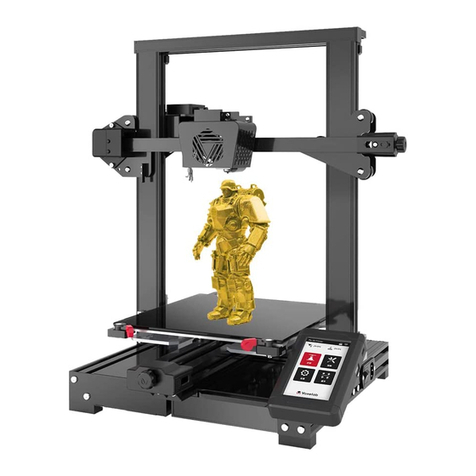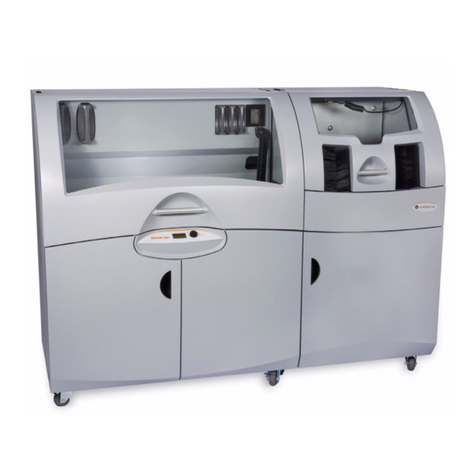StoneFlower Ceramic 3D Printing KIT Basic User manual

Ceramic
3D Printing KIT
Basic/Standard/Pro
User Manual
Eching, 2021

2 | P a g e

3 | P a g e
Contents
Disclaimer ...........................................................................................................................................4
Intended use ......................................................................................................................................4
Ceramic 3D Printing KIT.....................................................................................................................5
Your Ceramic 3D Printing KIT at glance............................................................................................. 5
Print head ................................................................................................................................................... 6
Ram extruder............................................................................................................................................. 7
Control unit 3.0 .......................................................................................................................................... 8
Specifications .....................................................................................................................................9
Printing......................................................................................................................................................... 9
Electrical ..................................................................................................................................................... 9
Physical dimensions and materials...................................................................................................... 9
Cautions.................................................................................................................................................... 10
Getting started.................................................................................................................................11
General notices ...................................................................................................................................... 11
Printer Mode with logical input signal, 0..5V................................................................................... 12
Printer Mode with input from extruder motor connector ........................................................... 17
Regulation of the Control Unit 3.0 ..................................................................................................... 20
Connection of the extruders to the control unit............................................................................ 21
Assembly and installation of the print head................................................................................... 22
Assembly of the ram extruder............................................................................................................. 23
Start the clay extrusion.......................................................................................................................... 26
Printing...............................................................................................................................................27
Infinite printing..................................................................................................................................28
Micro-printing set .............................................................................................................................29
Assembly ................................................................................................................................................... 29
Parameters of the firmware................................................................................................................. 29
Troubleshooting................................................................................................................................32
EC Declaration of conformity ........................................................................................................33

4 | P a g e
Disclaimer
Please read and understand the contents of this installation and user manual.
Failure to read the manual may lead to personal injury, inferior results or damage
to the Ceramic 3D Printing KIT and/or 3D printer. Always make sure that anyone
who uses the 3D printer knows and understands the contents of the manual to
make the most out of the Ceramic 3D Printing KIT.
The conditions or methods used for assembling, handling, storage, use or disposal
of the device are beyond our control and may be beyond our knowledge. For this
and other reasons, we do not assume responsibility and expressly disclaim liability
for loss, injuries, damage, or expense arising out of or in any way connected with
the assembly, handling, storage, use or disposal of the product.
The information in this document was obtained from sources which we believe are
reliable. However, the information is provided without any warranty, express or
implied, regarding its correctness.
Intended use
Ceramic 3D Printing KIT is designed and built for dispensing and deposition of clay
and porcelain within a commercial/business environment, being installed in
compatible desk top 3d printer. Ceramic 3D Printing KIT is precise, safe and salient.
It is perfect for prototyping and small serial production of ceramic wares,
sculptures, architectural models etc. from clay/porcelain of high viscosity that
provides good mechanical stability to complex shapes upon printing.
Although we achieved a very high standard in the reproduction of 3D models with
the usage of KIT, the user remains responsible to qualify and validate the
application of the printed object for its intended use. While we do not put any
limitations on the choice of materials for extrusion with the KIT, we recommend to
use clays and porcelains of moderate viscosity. Using too viscous material lead to
a large loads on the motors and accelerated wear of the components. Extruder is
designed to work under mechanical pressures below 10bars, and may break at
higher loads. The user remains responsible to the control of the content of material
and absence of any components, which may dissolve, corrode, or damage the
components of the KIT upon extrusion.
The KIT is not food grade.

5 | P a g e
Ceramic 3D Printing KIT
This user manual is designed to help you start your clay printing experience.
Learn everything about using your KIT by following the instructions in
this user manual and experience how easy it is to produce great quality prints.
Your Ceramic 3D Printing KIT at glance
Figure 1.
1. Print head
2. Ram extruder
3. Hose for the material
4. Control unit and power source
5. Nozzles
6. Cables
7. Micro printing set
Micro printing set is not shown, and included in all KITs, except Basic

6 | P a g e
Print head
Figure 2.
1. Stepper motor
2. Auger screw
3. Stator
4. Nozzle
5. Push-in connector
6. Mount
7. Screws M5
8. threaded pin
9. Shaft of the motor
10. Threaded pin, holding
the bearing

7 | P a g e
Ram extruder
Figure 3.
1. Lid of the barrel
2. Barrel
3. Seal
4. Plunger
5. Body
6. Lead screw
7. Square nut
8. Lid
9. Geared stepper motor

8 | P a g e
Control unit 3.0
Figure 4.

9 | P a g e
Specifications
Printing
Printing technology direct mechanical extrusion
Ram extruder capacity 05L (ram extruder S)
1.5L (ram extruder L)
Nozzle diameters 1.0, 2.0, 2.5mm
Layer resolution 0.3 … 2mm
Print speed 30mm/s … 100mm/s
Travel speed up to 100mm/s
Print head weight 450g
Pipe diameter/length 12mm X 400mm
Electrical
AC input 100-240V, 50-60Hz
Operating voltage, DC 24V, 6A
Physical dimensions and materials
Print head
Dimensions WxDxH = 36x40x180mm
Inlet plug-in connector, 12mm
Nozzle adapter 1/4inch x M6
Weight 450g
Material stainless steel (auger screw,
connector), nickel-plated brass
(body),
Ram extruder S, 0.5L
Capacity 0.5l (900g of clay)
Internal diameter/length of barrel 45.2mm/380mm
External diameter/length 80mm/930mm
Supplied with 50cm long PU pipe 12x8mm.
Material of the barrel PVC.
Materials of plunger Nylon, rubber seal
Weight 3.6kg
Ram extruder S, 1.5L
Capacity 1.5l (2700g of clay)
Internal diameter/length of barrel 67.8mm/480mm
External diameter/length 110mm/1300mm
Supplied with 50cm long PU pipe 12x8mm.
Material of the barrel PVC.
Materials of plunger Nylon, rubber seal

10 | P a g e
Weight 5.7kg
Control unit
Dimensions WxDxH 260x160x90mm
Material ABS/POM, rubber seal
Weight 0.7kg
If the KIT is used with the materials other than wet clay/porcelain, please check
chemical compatibility with the components of the KIT first.
Conditions
Ambient operation temperature 18 … 32 C
Storage temperature 0 … 32 C
Cautions
CAUTION: The Ceramic 3D Printing KIT has moving parts that can cause
injury. Never reach inside of the Ceramic 3D Printing KIT while it is in
operation. Do not use or power on partly or completely disassembled
Ceramic 3D Printing KIT. Always control Ceramic 3D Printing KIT with the
power switch on the back of control unit.
CAUTION: When connecting or disconnecting parts of Ceramic 3D
Printing KIT from the control unit, ensure that the power supply is turned
off. Connection of motors to powered control unit may irreversibly
destroy electronics of the KIT.
CAUTION: Only use the power supply provided with your Ceramic 3D
Printing KIT.

11 | P a g e
Getting started
General notices
Any slicing software is compatible with the KIT: Cura 3D, Repetier, Slic3r, Simplify3D
etc. Before printing you have to set/change several variables in the slicer.
1. Set target temperatures in the slicer of extruder and heated bed to zeros to
disable heating and temperature control. Usually those settings one can make in
the slicer.
2. Set the nozzle diameter in the slicer. By default the KIT comes with 1mm, 2mm,
2.5mm nozzles. Nozzles from micro printing set are color-coded:
Dark Green
14 Gauge
1.55mm
Black
16 Gauge
1.19mm
Jade Green
18 Gauge
0.84mm
Light pink
20 Gauge
0.6mm
Royal blue
22 Gauge
0.41mm
Red
25 Gauge
0.26mm
3. Hardware settings
Feeding clay, the print head should make about 1 to 3 rotations per second. If the
print head does not rotate fast enough, printing may be difficult of impossible. One
can accelerate the rotation speed of the print head changing microstepping
settings in the control unit.
4. The KIT can work in two modes: KIT and PRINTER. One can switch between
modes using the button of the control unit.
KIT mode: the control unit rotates the motors of the print head and ram, and one
can vary the speed of rotation.
Printer mode: control unit uses the input signal, coming from the 3d printer to run
the motor at the speed, set in the g-code, printer at the moment. The printing can
be controlled automatically. Use of this mode requires the control unit to be
connected to the printer, and parameters of the printer selected as described
below.
One can use logical input signal STEP and GND (Ground) with voltage
amplitude up to 5V, or signal, generated by the printer for the extruder motor, and
ranging from -24 to +24V (or from -12V to +12V depending on the printer). Logical
input signal is preferable.
Never use both types of the input signal simultaneously. This will
shortcut logical and power circuits of the printer, and will irreversibly
damage electronics.

12 | P a g e
Printer Mode with logical input signal, 0..5V
You will need to find pins labeled STEP (STP) and GROUND (GND)
Signal pins are easily available on motherboards RAMPS, SMART, RUMBA, SAV MKI,
Megatronics, AZSMZ Mini, Gen7, Sanguinololu, PiBot, RADDS, Smoothieboard,
Azteeg X3, MKS GenV1.4 and similar or compatible boards. Those are most popular
boards on the market.
Wiring diagram: connection of the STEP (STP) and GND pins to the logical input

13 | P a g e
You have to set correct number of microsteps per mm of filament, Ne, in your
printer firmware and/or g-code. The number of micro-steps depends on many
parameters, including diameter of the filament. If you want to keep printing both,
clay and plastic, keep default diameter of filament, and for clay printing only
change the number of microsteps and nozzle diameter.
The number of microsteps per mm of filament can be calculated as follows
, (1)
Here
ris the reduction ratio of the gearbox, installed in the KIT (is given in the table
below).
pis the pitch of the lead screw in the ram extruder (is given in the table below).
dfis the diameter of the filament, you set in the slicer. If you do not print plastic, you
can set arbitrary value (nozzle diameter, as an example).
Dis the diameter of the plunger in the ram extruder (is given in the table below).
Table 1
Parameters of the KIT
Extruder S, 0.5L
Extruder L, 1.5L
Micro Printing SET
Gear ratio, r
99.05
46.66
Pitch of the lead screw, p
2mm
3mm
Diameter of the plunger, D
45.2mm
67.8mm
27mm
TIP: The number of microsteps/mm of filament can be set in the slicer or
right in the beginning of the g-code with the command:
M92 E200
Here Ne= 200 microsteps/mm.
TIP: You can calculate Ne on the web site, if you choose right type of the
ram extruder, and control unit V1.
https://www.stoneflower3d.com/support/ceramic-3d-printing-kit-and-print-head/
Example 1:
Ram extruder S, diameter of filament is set to 1.75mm, From Eq. (1)
microsteps/mm
Example 2:
Ram extruder L, diameter of filament is set to 2.5mm, From Eq. (1)
steps/mm

14 | P a g e
Signal pins: Typical examples
Ramps 1.4 (Reprap Arduino Mega Pololu Schield)
Ground pins can be found elsewhere.
If your board has plug-in drivers, as Ramps 1.4 does, you can reach necessary pins
by unplugging a stepper motor driver. Driver pins are labelled accordingly:
Left side: board with plug-in drivers. Right side: labelling of the plug-in driver.

15 | P a g e
Smoothieboard V1
Here are those pins for E0 extruder (all unnecessary information was removed):

16 | P a g e
Makerbase MKS GEN V1.4

17 | P a g e
Printer Mode with input from extruder motor connector
This approach can be used for any printer, but requires more sophisticated choice
of extrusion parameters, some experimenting with stepper driver settings, and may
not work with some stepper motor drivers.
Introduction
The motherboard of the 3d printer generally has two types of circuits: logical
circuits and power circuits. Power circuits drive the stepper motors, and voltage
there varies periodically. The black input 2-pin connector of the control unit can
work with the signal from power circuits, reaching +24V. The wiring diagram in this
case:

18 | P a g e
The control unit extracts pulses from an input signal, converts them into a
logical pulses, and use those pulses to rotate motors of the kit via embedded
drivers.
Signal conversion inside the control unit
One has to bear in mind, that the frequency of voltage oscillations in the
power circuit is significantly less than in logical circuits. As the result, the stepper
motor, connected to the control unit, will rotate slowly than when it is directly
connected to the motherboard of the printer. Typically the speed reduction is
around
(microstepping of the extruder stepper driver in 3d printer)×f,
where the factor f typically equals to 2 or 4, depending on which of two phases of
the power circuit is used as an input. For example if the microstepping is set to 16,
the motor speed reduction will be 32:1 or 64:1.
This speed reduction has to be taken into account in the settings of your slicer
or in g-code or in the firmware of your printer via corrected number of microsteps
per mm of extruded filament. If you use the control unit V3.0 with input signal from
extruder connector of the 3d printer, the number of micro steps per mm of filament
can be calculated via Equation
, (2)
Here nis the number of microsteps, set for the stepper motor driver of extruder in
your 3d printer. Typical value is 16, but values 2, 4, 8, and 256 are also possible for
different printers. Find this value in the manual, or consult the manufacturer. Kit
cannot work with drivers, set to the full-step mode, i.e. at n= 1.
ris the reduction ratio of the gearbox, installed in the KIT (is given in the table
below).
pis the pitch of the lead screw in the ram extruder (is given in the table below).
dfis the diameter of the filament, you set in the slicer. If you do not print plastic, you
can set arbitrary value (nozzle diameter, as an example).
Dis the diameter of the plunger in the ram extruder (is given in the table below).

19 | P a g e
TIP: The number of microsteps/mm of filament can be set in the slicer or
right in the beginning of the g-code with the command:
M92 E200
Here Ne= 200 microsteps/mm.
TIP: You can calculate Ne on the web site, if you choose right type of the
ram extruder, and control unit V2.1.
https://www.stoneflower3d.com/support/ceramic-3d-printing-kit-and-print-head/
Table 2
Parameters of the KIT
Extruder S, 0.5L
Extruder L, 1.5L
Micro Printing SET
Gear ratio, r
99.05
46.66
Pitch of the lead screw, p
2mm
3mm
Diameter of the plunger, D
45.2mm
67.8mm
27mm
Example 1:
Ram extruder S, diameter of filament is set to 1.75mm, and stepper driver in the
printer is set to 16 microsteps. From Eq. (2)
microsteps/mm
Example 2:
Ram extruder L, diameter of filament is set to 2.5mm, and stepper driver in the
printer is set to 4 microsteps. From Eq. (2)
steps/mm
How do I check whether the number of microsteps is correct?
The print head of the KIT requires 3200 (version 2.0) or 800 microsteps (version 2.1)
to make a single turn. Ask the printer with the connected KIT to extrude
corresponding amount of filament and check how many turns it makes.
For example if you have set Ne= 1901, required extrusion length is 800*2*16/1901 =
13.47mm. Send to the printer the following command:
G1 F200 E13.47.

20 | P a g e
Regulation of the Control Unit 3.0
“KIT/PRINTER” switches control over the motors from the KIT to printer and back.
Start/Stop (►/■)the motors in the “KIT” mode
“RETRACTION/FEED”switches direction of the motors between feed and retraction
“Acceleration of print head”
Feeding clay, the print head should make about 1 to 3 rotations per second. If the
print head does not rotate fast enough, you can use this regulator, to accelerate
it.
“Speed of extrusion”Regulates the feed rate in the KIT mode. The range of
available feed rates can be reprogrammed in the firmware of the control unit, if
necessary. Contact us to get the firmware, or details about this option.
This manual suits for next models
2
Table of contents
